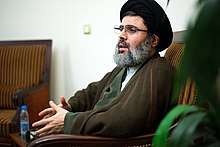Hashim Safi Al Din
Hashim Safi Al Din (Sayyed Hashem Safieddine) is a Lebanese Shia cleric, senior Hezbollah official and a maternal cousin of the secretary general of Hezbollah, Hassan Nasrallah.[1] He is the head of Hezbollah's Executive Council and a Specially Designated Global Terrorist,[2][3] and generally considered the "number two" in Hezbollah.[4]
Hashim Safi Al Din | |
|---|---|
 | |
| Head of Hezbollah's Executive Council | |
| Assumed office July 2001 | |
| Personal details | |
| Nationality | Lebanese |
| Political party | Hezbollah |
Early life
Hashim Safi Al Din was born in 1964 in Deir Qanoun En Nahr, south Lebanon, to a respected Shia family.[5] He is a maternal cousin of Hassan Nasrallah.[6] His brother, Abdallah Safi Al Din, is Hezbollah's representative to Iran.[5]
Hashim Safi Al Din studied theology in Najaf, Iraq, and in Qum, Iran, together with Nasrallah,[7] until he was recalled to Lebanon by Hassan Nasrallah in 1994.[2]
Career
In 1995 he was promoted to the Majlis al-Shura (Consultative Assembly), the highest council in Hezbollah.[2] He was also appointed head of the al-Majlis al-Jihadi.[2] The Executive Council, of which he is President, oversees Hezbollah's political, social, and educational activities.[3][8]
Al Din is among three major leaders of Hezbollah, the other two are Hassan Nasrallah and Naim Qassem.[9] He is also regarded as second only to Nasrallah.[7]
In 2006 he was reportedly promoted by Iran as a possible successor to Hassan Nasrallah for the post of Secretary-General of Hezbollah.[2][10]
Al Din is one of six clerics who are members of the shura council of Hezbollah.[11] He is also the head of the executive council of the group (also known as Shura Tanfiziyah),[12] to which he was elected in the general assembly meeting in July 2001.[13][14] In addition, he is one of nine members of the deciding consultative council (Shura al-Qarar), which is the top body of the group.[15]
In October 2008, Al Din was elected to succeed Nasrallah as secretary general of Hezbollah in the general meeting.[16][17] His appointment as heir apparent to Nasrallah was supported by Iranians.[15] In 2009, Al Din was again elected to the shura council.[18] He was appointed Hezbollah's military commander of the Southern Lebanon region in November 2010.[19][20]
In 2017 Al Din was designated a terrorist by the US Department of State.[5]
Personal life
In June 2020 his son, Sayyed Reza Hashim Safi Al Din, married Zeinab Soleimani, daughter of former Qods Force Commander late Qassem Soleimani.[4]
References
- "Lebanon: Hezbollah's Rising Star". Stratfor. 17 November 2009. Retrieved 15 March 2013.
- David A. Daoud (4 June 2017). "State Department Blacklists Hashem Saffiedine". Foundation for Defense of Democracies. Archived from the original on 6 June 2017.
- "State Department Terrorist Designations of Hashem Safieddine and Muhammad al-Isawi". United States Department of State. 19 May 2017. Archived from the original on 6 June 2017.
- "Slain Iran Commander's Daughter Marries Son of Senior Hezbollah Leader". Radio Farda. 28 June 2020. Retrieved 7 July 2020.
- "Senior Hezbollah figure Hashem Safi al-Din publicly stated Hezbollah participates in the campaign in south Syria". Intelligence and Terrorism Information Center. 29 July 2018.
- Ahmad Rafat (7 July 2020). "A Marriage of Convenience Bolsters Iran's Mideast Presence". Kayhan Life. Retrieved 7 July 2020.
- "Sayyed Nasrallah re-elected for another term". The Weekly Middle East Reporter. 5 December 2009. Retrieved 24 March 2013.
- John Davison (21 May 2017). Potter, Mark (ed.). "Hezbollah calls U.S. administration 'mentally impeded' during Trump Saudi visit".
Sayyed Hashem Safieddine, president of the Iran-backed Shi'ite group's executive council, said Washington would not be able to do any real harm to Hezbollah.
- "IRGC-Hezbollah Captagon Ring Compromised by War Over Profits". Middle East Transparent. 27 April 2012. Archived from the original on 21 September 2013. Retrieved 22 March 2013.
- Shmuel Bar (29 October 2006). "Lebanese Hizballah – Political, Ideological and Organizational Highlights" (PDF). National Defense University. Archived from the original (PDF) on 6 June 2017.
According to reports from Iran, the Iranians have already appointed Hashem Safi-a-din, the head of the Executive Council and Nassrallah's cousin as his successor.
- Barry Rubin (2010). Guide to Islamist Movements. M.E. Sharpe. p. 329. ISBN 978-0-7656-1747-7. Retrieved 7 February 2013.
- Dominique Avon; Anaïs-Trissa Khatchadourian; Jane Marie Todd (10 September 2012). Hezbollah: A History of the "Party of God". Harvard University Press. p. 215. ISBN 978-0-674-06752-3.
- Ahmad Nizar Hamzeh (2004). In The Path of Hizbullah. Syracuse University Press. p. 45. ISBN 978-0-8156-3053-1.
- "Hezbollah (part I)" (PDF). Intelligence and Terrorism Information Center. July 2003. Retrieved 7 February 2013.
- Bar, Shmuel (29 October 2006). "Lebanese Hizballah – Political, Ideological and Organizational Highlights" (PDF). Center for Complex Operations. Retrieved 7 February 2013.
- Cohen, Dudi (13 October 2008). "Nasrallah replacement chosen". Ynetnews. Retrieved 7 February 2013.
- "Kuwaiti daily reports extension of Nasrallah mandate". Now Lebanon. 1 November 2008. Retrieved 15 March 2013.
- Shapira, Shimon (17 December 2009). "Has Hizbullah Changed?" (PDF). Intelligence and Terrorism Information Center. Retrieved 7 February 2013.
- Sadiki, Larbi (21 June 2011). "Hezbollah and the Arab revolution". Al Jazeera. Retrieved 7 February 2013.
- Timmerman, Ken (1 December 2010). "UN: Iran Ordered Rafik Hariri Execution". Newsmax. Retrieved 7 February 2013.